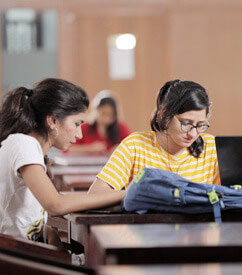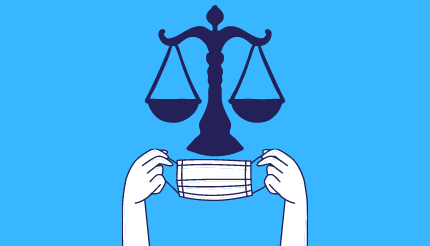ABSTRACT
December 2019 marked the beginning or outbreak of one of the most dangerous contagious diseases, known as Novel Corona Virus, COVID19 in Wuhan District of China. The World Health Organization declared the outbreak a Public Health Emergency of International Concern on 30th January’2020 and a pandemic on 11th March 2020. Since the outbreak of COVID 19, our lives have changed completely as now we need to maintain social distancing, wear a mask, sanitize ourselves in order to prevent ourselves from getting infected with the deadly virus, which has taken away the precious lives of millions of people. Thanks to the virtual platform, as this is one alternative means through which a number of IT Companies, MNCs, educational institutions etc, are still carrying out their work.
This disease has affected each and every sphere of human life and the legal field is no exception to this rule. We all know in every State’s High Court, District Court, Sessions Court or CJM Court, the scene is always overcrowded as a number of Advocates with their clients appear in the court of law, to resolve their disputes and hearings for the day. As such, how the courts could be allowed to function the same way, as during any other normal day, its functioning too got adversely affected. Through this article, an endeavour shall be made to study, as to how during the COVID19 Pandemic period, the functioning of the courts got affected, whether the pending cases got disposed off on the virtual platform, or got postponed to a different date. Whether the legal fraternity is able to adapt and adjust to the ‘New Normal’ or finding it difficult to cope with the new changes which has been introduced for the effective functioning of the courts.
Key words: Pandemic, Virtual, COVID, Advocate, Sanitize, Legal, Mask, Outbreak, Dispute, Adverse
INTRODUCTION
COVID19 or Novel Corona virus shall be remembered in the history of Global Pandemics as one of the greatest challenges human race ever faced since World War II. Just like any other pandemics COVID 19 too ascended amongst us without giving us the slightest hint or forewarning. The courts responded with equal vigour setting new rules for the court to operate. This included limiting the number of lawyers within the court rooms, sanitizing the courtrooms in between the hearings; mandatory checking of temperature at the court entrance and social distancing was maintained within the court premises.
These rules were imposed not just in the Supreme Court, but all other High Courts and lower courts across the length and breadth of the country. India’s Prime Minister Narendra Modi, announced a nationwide Lockdown for 21 days from March 25’2020 (12 AM) till April 14’ 2020.[1] This announcement immediately changed the pace of work, for every citizen of India be he a student, a professional of any field, a daily wage earner or a businessman. Numerous questions and thoughts ran across our minds now, as our whole Life came to a standstill and the first question which came to everyone’s mind is ‘How will we earn our livelihood now?’; ‘How will we complete our syllabus or attend classes now? Virtual platform now became the most efficient way for communication, conduct online classes and exams, webinars, complete undone projects etc.
The Courts too were equally affected. Whatever be the circumstances access to justice cannot be denied and just because of the lockdown, functioning of the courts could not be suspended. If the courts were closed for months, together at a stretch, that would lead to a backlog and delays in the dispensation of Justice. There would be a direct impact on the filing of civil cases, if restrictions are imposed on Economic Activities and even for Criminal cases, the accused would suffer detention as under trials for extended periods, if there is a delay in the examination of witnesses and completion of investigation. All emergencies vest substantial powers in the Executive and more so in a public health crisis increased Government actions may be necessary to preserve the Public Health and Welfare during such a Crisis. In the words of Justice D.Y. Chandrachud, ‘Irrespective of Governmental actions and restrictions, it is above all the duty of courts civil, criminal and constitutional courts to protect the rights of citizens to, ensure governmental accountability in the Rule Of Law.’ Immediately an investigating method through which courts could function during the lockdown was started. [2]
There was longstanding work which was being done as part of the National Policy for ICT enablement of the Indian Judiciary and the E-Courts Project [2] was put to test. Almost immediately after the lockdown Video Conferencing hearings took place commencing with the Supreme Court and then spreading across the High Courts and the District Courts. What can be emphasized at this point is that, it could not be possible overnight to switch to video conferencing technology, if we did not have a robust infrastructure and the fact that the legal fraternity could switch-over to video conferencing technology and to use both the hardware and software which was at the command of the judiciary, was because of the fact that a robust infrastructure had been created in the past and over the last several months, when Justice Chandrachud had been co-ordinating with the Chief Justice of the High Courts, the Chairpersons of the Computer Committees and the project co-ordinators, the District Judiciary and the High Courts. [2]
CHANGES IN THE COURT ROOM
Video Conferencing and E-Filing were the two distinct changes which were embraced.
VIDEO CONFERENCING
All Courts across the country has been directed by the Supreme Court in the wake of COVID19, to extensively use video conferencing for judicial proceedings. During the Pandemic the Supreme Court exercised its plenary power under Article 142 [3] of the Constitution to direct all High Courts to frame a mechanism for use of technology.
A Standard Operating Procedure dated April 15, 2020 [4] was issued by the Supreme Court of India for filing and listing of urgent matters and hearing of cases is being conducted through video conferencing to vanquish the lockdown. Special courts for video conferencing have been designated by High Courts of various Indian States. Litigants have been exempted from paying the appropriate court fees [4] and they have been also allowed by the court registry to directly present extremely urgent matters to the court without filing the proceeding. All subordinate courts in the State have been instructed by the Hon’ble High Courts of various states as far as criminal matters are concerned to entertain only urgent matters, for instance: orders for grant of stay, anticipatory bail applications, remand orders and bail. Trial matters of both civil and criminal cases are abandoned if it does not require urgency. [4] Discretion has been given to the principal district judges of the subordinate courts to control their own operation and functionality. [4]
Initially Video Conferencing posed a challenge to the learned arbitrators and senior counsels due to lack of practice and expertise but with every passing day the fraternity of arbitrators and litigators have acquainted themselves with conducting of hearings via VC. Examination of witnesses through VC is quite difficult as it requires a lot more diligence and it should be ensured that nobody should prompt the witness during the examination. Presently the hearing listed for examination of witnesses has practically been adjourned as the lower courts are not equipped with the expertise or sophistication to deal with such matters. [4]
E-FILING-The High Court of New Delhi vide circular no.10 (IT)/DHC/2020 dated 11.06.2020 invited all concerned for the e-inauguration of the ‘Online e- Filing System of Delhi High Court’ on 13th June’2020.This facility was inaugurated by Hon’ble Mr. Justice D.N. Patel, Chief Justice Delhi High Court. [5]
This facility enabled the Advocates/litigants-in-person to file fresh cases/ caveat as well as applications/ reply/ rejoinder/ documents/ vakalatnama etc. in the pending cases either from their chamber, office, residence or any other place at any time, without the necessity of personally visiting the Filing Counters or Designated Counters. [5]
Electronic Court Filing (ECF) is the solution that allows those systems or entities participating in the e-filing process to communicate and exchange data with one another. The primary system utilized to prepare and submit court filings electronically is known as an Electronic Filing Service Provider or EFSP. [6]
ADVANTAGES OF E-FILING: One of the most important advantages of E-Filing is that it is very convenient to file as it remains open for 24x7. Court Fees can also be paid from the comfort of one’s office or party’s home using credit card or internet banking. One of the feasibility is that, an e-filing system which is properly designed to provide online access to files will permit Attorneys representing parties to have immediate access to the filings as soon as they are up on site.
E-COURTS PROJECT- The e-Courts project was conceptualized on the basis of the ‘National Policy and Action Plan for implementation of Information and Communication Technology (ICT) in the Indian Judiciary-2005’ submitted by e-Committee, Supreme Court of India with a vision to transform the Indian Judiciary by ICT enablement of Courts.
Phase I of the e-court project was from February 2007, until March 2015, with a sanctioned outlay of 935 crores. [6] Video Conferencing between courts and jails were governing 840 locations. [6] A Case Information Software (CIS) was developed as part of the e-Courts project.CIS Modules 1.0 was also developed based on the Court periphery Model which was installed in all the District Courts and data of 2.2 Crores pending and disposed off cases were done and was then made available. Phase II of E-Courts Project was launched on 4th August 2015 and it covers 4 years or until the phase is completed at a cost outlay of 1670 crores. [6] As part of the e-courts Project various initiatives were being taken up. Model Rules of Video Conferencing has been sent out and circulated to the High Court for the purpose of acceptance. Among the critical features of the Model of VC Rules are the principles that all recourse to VC must be made available to public access. The essential nature of the Judicial Process which is access to the Public Court Room must be preserved in the course of VC. The 2nd important facet of the e-court project is the customization of the Operating System Software. Every District Court has its own website on which judicial orders are uploaded. The Court, the spine of the CIS is the CNR number. The CNR Number is attached to a case. It’s a Case Number Record, it’s a unique identifier to each case which is pending and which is being disposed off throughout the country. The CNR number can be converted to QR Code images by simply scanning the QR Code the user can get the entire case history of the case. E-Seva Kendras has been setup in a principal location in every High Court with a pilot and then one pilot location in the District. The idea of setting up E-Seva Kendras is to cover the technological divide.
CONCLUSION- The wheels of justice should move on and the Indian Judiciary has very successfully adapted to the new mode of justice dispensation through the virtual platform though technical glitches are there. Virtual Courts are not a substitute of an open court hearing rather it facilitated in maintaining social distancing. But now virtual Court hearing shall be perceived as an important aspect of the judiciary which shall save travel expenses and time too.
Namrata Das
LLM (Crime and Criminology & IPR) 2019-20
Alliance School of Law
1Corona virus in India: 21-day lockdown begins; key highlights of PM Modi’s speech. www.businesstoday.in
2Justice Dhananjaya Y. Chandrachud’s #Nyaya Special edition #Webinar on ‘Future of Virtual Courts and Access to Justice in India’. NALSAR University of Law May 24, 2020
3Top Court Issues Guidelines For Court’s Functioning Amid COVID-19 Crisis. www.ndtv.com
4Report Impact of COVID19 on Court Operations and Litigation Practice.Pg-50 www.ibanet.org
5Circular-online e-filing-revise-RG(2) Orders during Lockdown Inauguration Of Online e-FILING( High Court) delhidistrictcourts.nic.in-Delhi District Courts: Official Website.
67 Steps to Electronic Filing with Electronic Court Filing 4.0 Crisis pg-2 www.oasis-open.org








